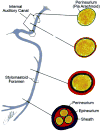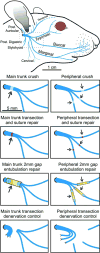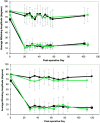Rodent facial nerve recovery after selected lesions and repair techniques
- PMID: 20048604
- PMCID: PMC4394362
- DOI: 10.1097/PRS.0b013e3181c2a5ea
Rodent facial nerve recovery after selected lesions and repair techniques
Abstract
Background: Measuring rodent facial movements is a reliable method for studying recovery from facial nerve manipulation and for examining the behavioral correlates of aberrant regeneration. The authors quantitatively compared recovery of vibrissal and ocular function following three types of clinically relevant nerve injury.
Methods: One hundred seventy-eight adult rats underwent facial nerve manipulation and testing. In the experimental groups, the left facial nerve was either crushed, transected, and repaired epineurially, or transected and the stumps suture-secured into a tube with a 2-mm gap between them. Facial recovery was measured for the ensuing 1 to 4 months. Data were analyzed for whisking recovery. Previously developed markers of co-contraction of the upper and midfacial zones (possible synkinesis markers) were also examined.
Results: Animals in the crush groups recovered nearly normal whisking parameters within 25 days. The distal branch crush group showed improved recovery over the main trunk crush group for several days during early recovery. By week 9, the transection/repair groups showed evidence of recovery that trended further upward throughout the study period. The entubulation groups followed a similar recovery pattern, although they did not maintain significant recovery levels by the study conclusion. Markers of potential synkinesis increased in selected groups following facial nerve injury.
Conclusions: Rodent vibrissal function recovers in a predictable fashion following manipulation. Generalized co-contraction of the upper and midfacial zones emerges following facial nerve manipulation, possibly related to aberrant regeneration, polyterminal axons, or hypersensitivity of the rodent to sensory stimuli following nerve manipulation.
Conflict of interest statement
The authors have no financial disclosures to make.
Figures







Similar articles
-
A novel videographic method for quantitatively tracking vibrissal motor recovery following facial nerve injuries in rats.J Neurosci Methods. 2015 Jul 15;249:16-21. doi: 10.1016/j.jneumeth.2015.03.035. Epub 2015 Apr 5. J Neurosci Methods. 2015. PMID: 25850078
-
Putative roles of soluble trophic factors in facial nerve regeneration, target reinnervation, and recovery of vibrissal whisking.Exp Neurol. 2018 Feb;300:100-110. doi: 10.1016/j.expneurol.2017.10.029. Epub 2017 Nov 8. Exp Neurol. 2018. PMID: 29104116 Review.
-
Long-term functional recovery after facial nerve transection and repair in the rat.J Reconstr Microsurg. 2015 Mar;31(3):210-6. doi: 10.1055/s-0034-1395940. Epub 2015 Jan 28. J Reconstr Microsurg. 2015. PMID: 25629206 Free PMC article.
-
Syngeneic Transplantation of Rat Olfactory Stem Cells in a Vein Conduit Improves Facial Movements and Reduces Synkinesis after Facial Nerve Injury.Plast Reconstr Surg. 2020 Dec;146(6):1295-1305. doi: 10.1097/PRS.0000000000007367. Plast Reconstr Surg. 2020. PMID: 33234960
-
Trigeminal Sensory Supply Is Essential for Motor Recovery after Facial Nerve Injury.Int J Mol Sci. 2022 Dec 1;23(23):15101. doi: 10.3390/ijms232315101. Int J Mol Sci. 2022. PMID: 36499425 Free PMC article. Review.
Cited by
-
The convergence of facial nerve branches providing whisker pad motor supply in rats: implications for facial reanimation study.Muscle Nerve. 2012 May;45(5):692-7. doi: 10.1002/mus.23232. Muscle Nerve. 2012. PMID: 22499096 Free PMC article.
-
Facial Paralysis Algorithm: A Tool to Infer Facial Paralysis in Awake Mice.eNeuro. 2025 Mar 4;12(3):ENEURO.0384-24.2025. doi: 10.1523/ENEURO.0384-24.2025. Print 2025 Mar. eNeuro. 2025. PMID: 39947904 Free PMC article.
-
The potential role of SCF combined with DPCs in facial nerve repair.J Mol Histol. 2025 Jan 7;56(1):67. doi: 10.1007/s10735-024-10351-w. J Mol Histol. 2025. PMID: 39776268
-
Quantitative analysis of muscle histologic method in rodent facial nerve injury.JAMA Facial Plast Surg. 2013 Mar 1;15(2):141-6. doi: 10.1001/jamafacial.2013.430. JAMA Facial Plast Surg. 2013. PMID: 23329158 Free PMC article.
-
Electrophysiological assessment of a peptide amphiphile nanofiber nerve graft for facial nerve repair.J Tissue Eng Regen Med. 2018 Jun;12(6):1389-1401. doi: 10.1002/term.2669. Epub 2018 May 16. J Tissue Eng Regen Med. 2018. PMID: 29701919 Free PMC article.
References
-
- Lee J, Fung K, Lownie SP, Parnes LS. Assessing impairment and disability of facial paralysis in patients with vestibular schwannoma. Arch Otolaryngol Head Neck Surg. 2007 Jan;133(1):56–60. - PubMed
-
- Ryzenman JM, Pensak ML, Tew JM., Jr Facial paralysis and surgical rehabilitation: a quality of life analysis in a cohort of 1,595 patients after acoustic neuroma surgery. Otol Neurotol. 2005 May;26(3):516–21. discussion 521. - PubMed
-
- Coulson SE, O’dwyer NJ, Adams RD, Croxson GR. Expression of emotion and quality of life after facial nerve paralysis. Otol Neurotol. 2004 Nov;25(6):1014–9. - PubMed
-
- Kahn JB, Gliklich RE, Boyev KP, Stewart MG, Metson RB, McKenna MJ. Validation of a patient-graded instrument for facial nerve paralysis: the FaCE scale. Laryngoscope. 2001 Mar;111(3):387–98. - PubMed
-
- Lohne V, Bjørnsborg E, Westerby R, Heiberg E. I want to smile. How do individuals with facial paralysis resulting from surgical removal of an acoustic neuroma cope with daily living? Vard Nord Utveckl Forsk. 1986 Spring;6(1):311–9. - PubMed
Publication types
MeSH terms
Grants and funding
LinkOut - more resources
Full Text Sources
Other Literature Sources
Miscellaneous

